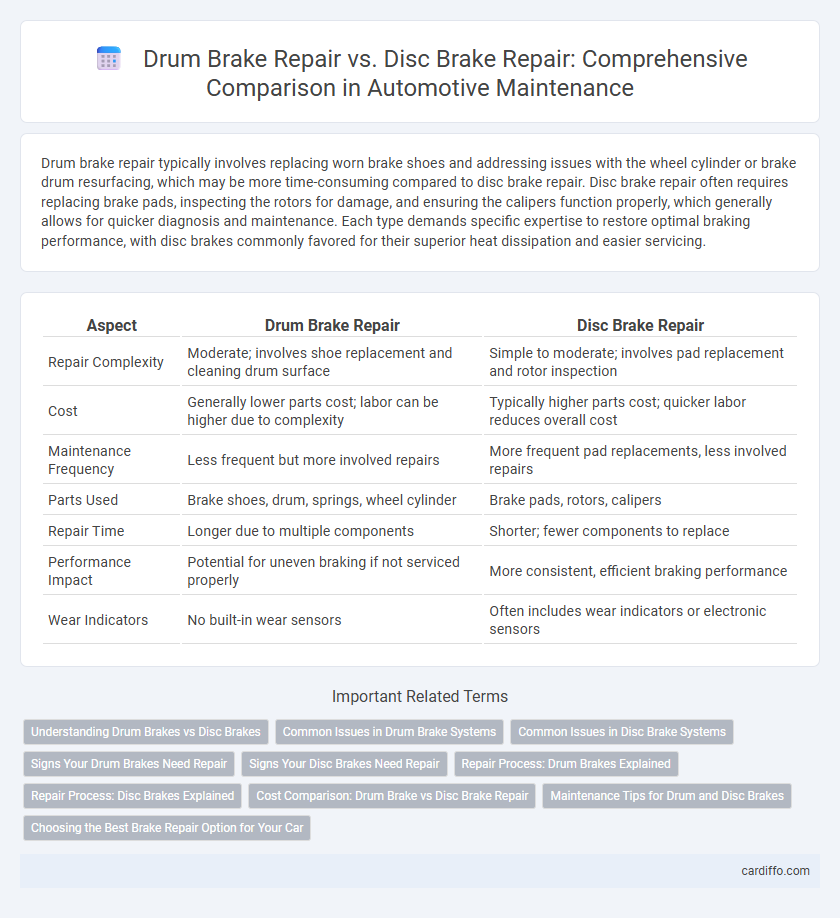Drum brake repair typically involves replacing worn brake shoes and addressing issues with the wheel cylinder or brake drum resurfacing, which may be more time-consuming compared to disc brake repair. Disc brake repair often requires replacing brake pads, inspecting the rotors for damage, and ensuring the calipers function properly, which generally allows for quicker diagnosis and maintenance. Each type demands specific expertise to restore optimal braking performance, with disc brakes commonly favored for their superior heat dissipation and easier servicing.
Table of Comparison
| Aspect | Drum Brake Repair | Disc Brake Repair |
|---|---|---|
| Repair Complexity | Moderate; involves shoe replacement and cleaning drum surface | Simple to moderate; involves pad replacement and rotor inspection |
| Cost | Generally lower parts cost; labor can be higher due to complexity | Typically higher parts cost; quicker labor reduces overall cost |
| Maintenance Frequency | Less frequent but more involved repairs | More frequent pad replacements, less involved repairs |
| Parts Used | Brake shoes, drum, springs, wheel cylinder | Brake pads, rotors, calipers |
| Repair Time | Longer due to multiple components | Shorter; fewer components to replace |
| Performance Impact | Potential for uneven braking if not serviced properly | More consistent, efficient braking performance |
| Wear Indicators | No built-in wear sensors | Often includes wear indicators or electronic sensors |
Understanding Drum Brakes vs Disc Brakes
Drum brakes consist of brake shoes pressing outward against a rotating drum, offering cost-effective durability but requiring more frequent adjustments and greater maintenance complexity. Disc brakes employ calipers squeezing pads against a rotor, providing superior heat dissipation, consistent stopping power, and easier pad replacement. Understanding the mechanical differences between drum and disc systems is essential for accurate diagnosis and selecting targeted repair techniques.
Common Issues in Drum Brake Systems
Drum brake systems commonly face issues such as brake fade, wheel cylinder leaks, and worn brake shoes causing reduced braking efficiency. Moisture and dust often accumulate inside drum brakes, leading to corrosion and uneven wear on the braking components. Addressing these problems promptly ensures safer vehicle operation and extends the lifespan of drum brake assemblies compared to disc brake systems.
Common Issues in Disc Brake Systems
Disc brake systems commonly face issues such as worn brake pads, warped rotors, and brake fluid leaks, which lead to reduced braking efficiency and increased stopping distances. Caliper problems like sticking or seizing can cause uneven pad wear and braking force imbalance. Regular inspection of brake lines, pads, and rotors is essential to prevent costly disc brake repairs and ensure optimal braking performance.
Signs Your Drum Brakes Need Repair
Worn or pulsating brake pedals, unusual noises like grinding or squealing, and reduced braking efficiency are key signs your drum brakes need repair. Visible brake fluid leakage or uneven braking force can also indicate internal drum brake issues. Timely inspection and maintenance prevent further damage and ensure safer driving conditions.
Signs Your Disc Brakes Need Repair
Signs your disc brakes need repair include squealing or grinding noises, reduced responsiveness when braking, and vibration or pulsing in the brake pedal. Visible wear on the brake pads or rotor grooves also indicates the need for immediate maintenance. Ignoring these symptoms can lead to decreased braking efficiency and increased risk of brake failure.
Repair Process: Drum Brakes Explained
Drum brake repair involves removing the drum to inspect and replace worn brake shoes, springs, and wheel cylinders, requiring careful adjustment of the self-energizing mechanism for optimal performance. Technicians must clean brake dust and apply brake lubricant to contact points to prevent noise and wear. Unlike disc brake repair, drum brake maintenance often demands more labor-intensive steps due to the enclosed design and complexity of internal components.
Repair Process: Disc Brakes Explained
Disc brake repair involves inspecting the brake pads, calipers, and rotors for wear or damage, followed by precise replacement or resurfacing to restore optimal braking performance. The repair process requires bleeding the brake lines to eliminate air bubbles, ensuring consistent hydraulic pressure and smooth brake response. Technicians must also verify caliper functionality and proper alignment to prevent uneven rotor wear and maintain vehicle safety.
Cost Comparison: Drum Brake vs Disc Brake Repair
Drum brake repair generally costs less than disc brake repair due to simpler components and easier maintenance, with average expenses ranging from $100 to $200 compared to $150 to $300 for disc brakes. Replacement parts for drum brakes, such as brake shoes and springs, are typically cheaper than disc brake pads and rotors, leading to lower overall repair costs. Labor costs for drum brake repair also tend to be lower because the repair process is less complex and time-consuming than disc brake servicing.
Maintenance Tips for Drum and Disc Brakes
Regular inspection of brake shoes and drum surfaces can prevent uneven wear in drum brake systems, while keeping disc brake rotors clean and free of rust ensures optimal braking performance. Adjusting drum brake clearance periodically maintains effective contact, whereas checking brake pads for thickness and replacing them timely is critical in disc brake upkeep. Using the correct brake fluid and flushing it as recommended supports both brake types by preventing corrosion and maintaining hydraulic efficiency.
Choosing the Best Brake Repair Option for Your Car
Drum brake repair often involves replacing worn brake shoes and addressing issues with the wheel cylinder, making it a cost-effective option for older or economy vehicles, while disc brake repair typically includes replacing brake pads and resurfacing or changing rotors, providing superior stopping power and heat dissipation suitable for modern and performance cars. Choosing the best brake repair option depends on your vehicle type, driving habits, and budget, with disc brakes preferred for enhanced safety and longevity. Regular inspection of both systems ensures timely maintenance and optimal braking performance.
Drum brake repair vs Disc brake repair Infographic

 cardiffo.com
cardiffo.com